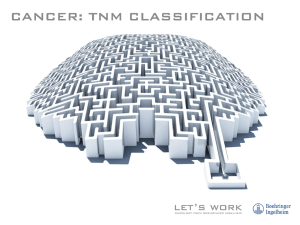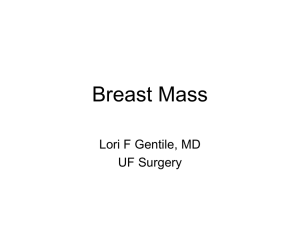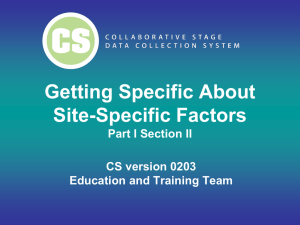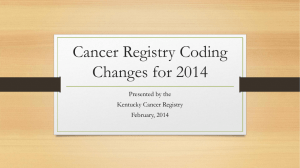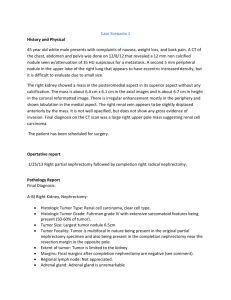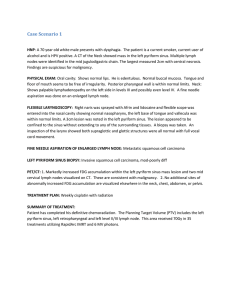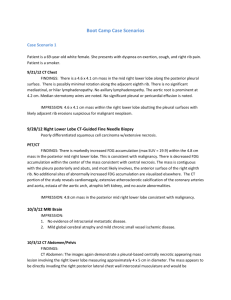Breast Collaborative Staging
advertisement
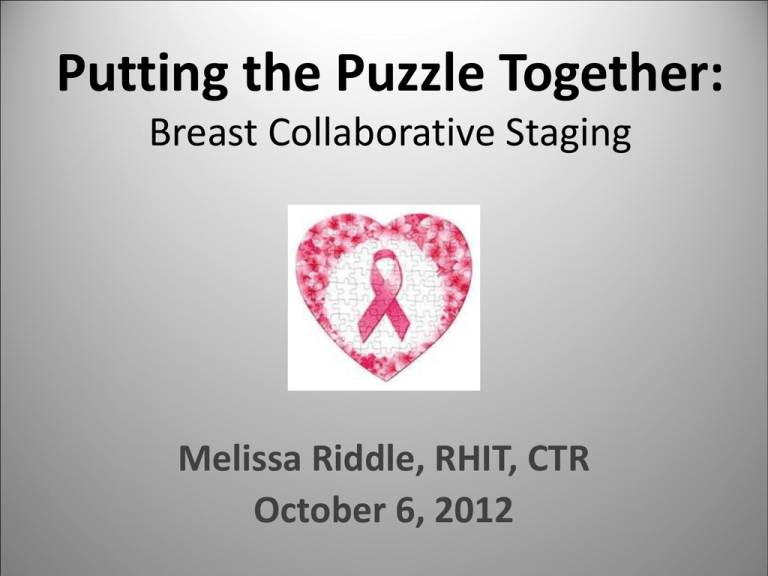
Putting the Puzzle Together: Breast Collaborative Staging Melissa Riddle, RHIT, CTR October 6, 2012 Objectives • Understand why collaborative staging was created • Learn the concepts of collaborative staging for breast cases Collaborative Staging • 5yr group effort among all standard setters in North America • Designed by and for cancer registrars to code the facts about a cancer case • General rules apply to all sites/histologies unless superseded by site-specific rule Collaborative Staging • Used for cases diagnosed 1/1/2004 and forward – CSv2 for cases diagnosed 1/1/2010 and forward • Derives: – AJCC TNM – SEER Summary • Understand SEER Summary and TNM is necessary in order to analyze cases Collaborative Staging • Allows both clinical and pathologic information to be used to determine stage – Pathologic information takes precedence Collaborative Staging • CS Solution: Mixed or “Best Staged” – Result: more relevant to actual practice – Fewer unstageable cases Computer Derives: Registrar records: T elements + c/p N elements + c/p M elements + c/p Site Specific Factors (tumor markers) c/pT c/p N And Stage Group SS77, SS2000 c/p M Data Elements: • CS Tumor Size • Regional LN Positive • CS Extension • Regional LN Exam • CS TS/Exten Eval • CS Mets @ DX • CS Lymph Nodes • CS Mets Eval • CS LN Eval • SSF 1-25 Breast CS Collaborative Staging • Evaluation Fields: – Code based on the procedure performed • Scans • Biopsies • Surgery – Derives the TNM as clinical or pathologic Breast Evaluation Codes CODE DESCRIPTION STAGING 0 Physical Exam; Imaging c 1 Diagnostic BX; FNA c 3 Resection without neoadjuvant TX p 5 Neoadjuvant TX; Based on Clinical information c 6 Neoadjuvant TX; Resection information yp 9 Unknown c Breast CS Data Items • • • • • • Tumor Size Extension Lymph Nodes Lymph Node Positive/Exam Distant Mets at Diagnosis Site Specific Factors 1-24 Tumor Size/Extension Tumor Size • Code the specific size of the tumor in mm – Convert any size in cm to mm • Pathologic size: – Take pathologic size over clinical – Record the invasive size Example: Invasive Ductal Carcinoma, 0.5cm; DCIS, 2cm Code Tumor Size: 005 Tumor Size • Special Codes: – 990 Microinvasion; Microscopic focus – 991-995 No specific size: “less than ___cm” – 996 seen on mammogram only but no size given – 997 Paget’s of nipple, no underlying tumor – 998 Diffuse Extension • In Situ only: 000 – No invasive disease • Invasive cancer without skin involvement: 100 • Skin involvement: 200 – Adherence, Attachment, Fixation, Induration & Thickening – Without diagnosis Inflammatory Breast CA CS BREAST: EXTENSION Example: L breast partial mastectomy Path report partial mastectomy: 2cm invasive ductal carcinoma invading into skin CS Extension: 200 (invade skin) Extension • Inflammatory Breast CA: – Based on clinical information – Codes based on percentage of breast involved: • • • • Code 600: 33% or less Code 725: more than 33% but less than 50% Code 730: more than 50% Code 750*: percentage unknown *Most common code for IBC Regional Lymph Nodes Lymph Nodes • Regional Lymph Nodes Only: – Do NOT code cervical or contralateral axillary LN – Includes Levels 1-3 Ipsilateral Axillary LN, internal mammary LN and Supraclavicular LN – Clinical vs. Pathologic • If the only information about involved regional LN is from physical exam or imaging- clinical • If there are positive LN found on sampling/dissectionpathologic Level 1 & 2 Axilla LN • Code 250: – Pathologic involvement LN • Code 255: – Clinical involvement moveable LN • Code 510: – Clinical involvement fixed/matted LN • Code 520: – Pathologic involvement fixed/matted LN • Code 600: – Axillary, NOS CS BREAST: LYMPH NODES Example: R breast modified radical mastectomy (MRM) Path from R MRM: 3cm invasive ductal carcinoma; 2/4 R axillary LN involved with metastatic disease CS LN: 250 (pathologic positive movable axillary LN) Reg LN Positive • Record all positive pathologic examined regional lymph nodes Example: 3/5 R axillary LN involved with invasive duct carcinoma CODE: 03 • Code 95: – Positive LN only on core biopsy or FNA • Code 98: – No regional LN were examined pathologically Reg LN Examined • Record the total number of pathologically examined regional LN Example: 3/5 R axillary LN involved with invasive duct carcinoma CODE: 05 • Code 95: – Regional LN examined by core biopsy or FNA only • Code 00: – No regional LN examined pathologically Distant Mets at Diagnosis Distant Mets • Code 00: – No evidence of metastatic disease • Code 10: – Involvement distant LN: • Cervical • Contralateral/Bilateral Axillary and/or internal mammary LN • Code 40: – Distant met site except distant LN Distant Mets • Code 42: – Further contiguous extension: • Skin over axilla, contralateral breast, sternum, upper abdomen • Code 44: – Involve any of the following: • • • • • • Adrenal gland Bone Contralateral breast- if stated metastatic Lung Ovary Sat nodules skin other than primary breast Distant Mets • Code 50: – Distant LN – Distant Sites (listed in codes 40-44) • Code 60: – Distant mets, NOS CS BREAST: METS AT DX Example R breast with palpable mass 4cm with fixed R axillary LN mass. CT AB/Pelvis: Innumerable liver mets CS Mets @ DX: 40 (Distant mets other than distant LN) Site Specific Factors Collaborative Staging • Site-Specific Factors – Not all 25 SSF are used for every case • Breast has the most with 24 to complete – Additional information needed to derive TNM – Prognostic Tumor Markers/Labs – Special Interest/Future Research – Other clinically significant information SSF 1: ER & SSF 2: PR • If there is any sample positive, record as positive • Do NOT record ER results from Oncotype DX or other multigene test • 010- Positive • 020- Negative • 997- Test ordered results not in chart • 999- Unknown SSF 3: Pos Level 1 & 2 LN • Based on pathologic information ONLY • Code 098: – No pathologically examined LN • Code 000: – Negative LN • Code 001-089: – Code the exact number of positive LN • Code 095: – Positive LN by biopsy or FNA SSF 7: BR Score • Priority Order: – BR Score – BR Grade • Codes 030-090: – BR Score range of 3-9 • Codes 110-130: – BR Grade: Low, Intermediate, High • Code 998: – No histologic exam of primary tumor HER 2 • SSF 8: IHC test value – Scores 0, 1+, 2+, 3+ • SSF 9: IHC interpretation – Record the pathologists interpretation of the test value: positive, negative, equivocal • SSF 10: FISH value – Record ratio as given – Code 991: ratio less than 1.00 • SSF 11: FISH interpretation – Record the interpretation of the test value HER 2 • SSF 14: Other/Unknown test – Statement in medical record on HER2, unknown type of testing performed – Other type of test performed • SSF 15: Summary of results – Based on codes in SSF 9, 11, 13 and 14 – Both IHC and FISH/CISH record results of FISH/CISH • Except when IHC is performed to clarify equivocal test of FISH/CISH SSF 16: ER, PR & HER2 • Identifies Triple negative patients • Code Pattern: – First digit: ER – Second digit: PR – Third digit: HER2 • Digits: – 0= negative – 1= positive • Information unknown on one or more test code 999 SSF 16 • Example: ER: positive (SSF1: 010) PR: positive (SSF2: 010) HER2: negative (SSF 15: 020) SSF 16 Code: 110 • Triple Negative patients code 000 SSF 22: Multigene Method • Assess: – likelihood of response to chemotherapy – evaluate prognosis or distant recurrence • Code 010: Oncotype DX • Code 020: MammaPrint • Code 030: Other test SSF 23: Multigene Result • Record the results of the multigene method: – Oncotype DX: Scores range 0-100 – MammaPrint: Low Risk or High Risk • Codes 000-100 – Record actual Oncotype DX score • Code 200: Low Risk • Code 300: Intermediate Risk • Code 400: High Risk SSF 24: Paget’s Disease • Record any mention of Paget’s disease – Pathologic takes precedence over clinical info • Negative exam of nipple – Interpret as no Paget’s disease • Pathology report mentions pagetoid involvement of nipple, Code 020 – Does NOT include pagetoid involvement of ducts or lobules Current Version CSv02.04 http://www.cancerstaging.org/cstage/manuals/coding0204.html Additional Help: http://cancerbulletin.facs.org/forums/ The Whole Picture • Now you can put these pieces together while using the CS Manual to create a beautiful picture! • Always read your notes for CS, they are the little pieces that create the whole! Thank You! Melissa Riddle, RHIT, CTR melissariddlespeaks@ymail.com




